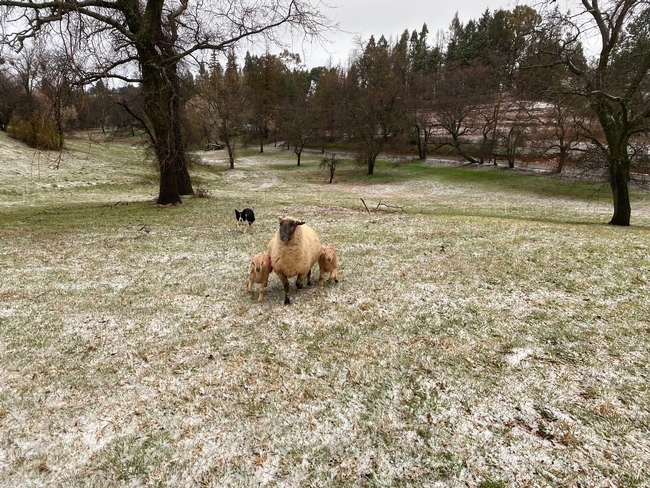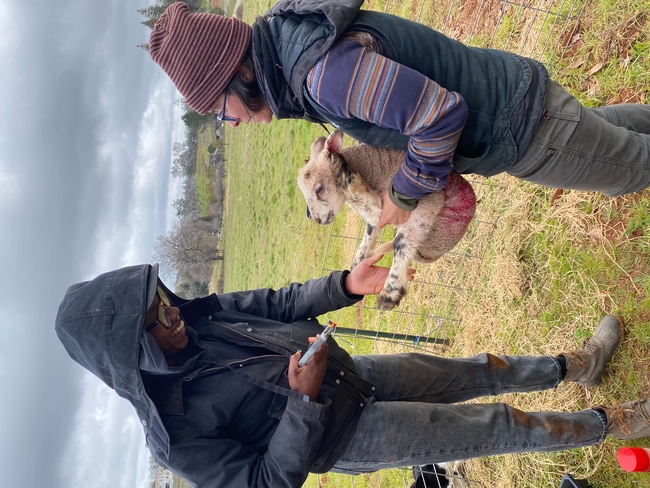Raising Livestock on Rangeland is not an Indoor Sport...
Larry McMurtry's novel, Lonesome Dove, was published the year I graduated from high school (way back in 1985 - before blogging was a word)! Four years later, the novel became one of my favorite television miniseries, featuring Robert Duvall, Tommy Lee Jones, and Danny Glover (among others). While there are a number of memorable scenes and lines (from both the book and the miniseries), one that sticks with me as a rancher is Agustus McCrae's eulogy for Danny Glover's character, Deets:
"Cheerful in all weathers. Never shirked a task."
I've been reminded of this line frequently over the last several weeks - as we've had cold rain and wind here in Auburn, and as other ranchers in California have been dealing with never-ending snow. Rangeland agriculture - grazing sheep, goats, and cattle on the vegetation that Mother Nature provides - requires us to tend to our animals regardless of the conditions we (and they) are facing. We may not always be cheerful about unrelenting snow or sweltering heat, but if we've ranched for very long, we know that we can't shirk a task when it comes to our livestock.
But working in all weathers is much easier when we're intentional about our management systems and production calendars. We lamb on pasture, so we time our lambing to coincide with what is usually the onset of rapid grass growth in late winter (we're still waiting for rapid growth this year). This system requires that our ewes have strong maternal abilities - that they can lamb mostly without our help, that they can turn our rangeland forages into enough milk for their lambs, that their lambs get up and going quickly, and that they can count at least to two. Rather than trust to luck, we've utilized an objective selection process that allows us to keep our best ewes and their daughters, while culling the ewes that don't measure up.
Our intentionality extends to our grazing management. On our winter rangelands, we have open hillsides that we graze before lambing begins, which allows us to save the more sheltered areas (with trees, brush, and topography that provide shelter from wind and rain) for lambing. We watch the weather diligently during lambing season - while sheltered paddocks are important, there's no better shelter for a lamb than a belly full of milk. If we know we have cold or wet weather coming in, we'll move the ewes to fresh feed so that they don't have to walk very far to fill their rumens with forage. And we've found a cost-effective, biodegradable plastic raincoat that helps keep the youngest lambs warm and relatively dry in really nasty weather.
Even the best management planning can't change the weather, though. Sometimes, like January-March last year, it doesn't rain at all. We adjusted by building larger paddocks in steeper terrain to give the ewes access to more forage. Sometimes we get sleet or even snow in early March; we adjust to these conditions by increasing the number of times we check the sheep (including checks every two to three hours during the night). This year, due to some extenuating family circumstances, we've purchased feed for the ewes to supplement what they are able to graze during the current stormy stretch.
And despite our best planning efforts, sometimes Mother Nature simply doesn't cooperate. I have friends who are spending 16-person-hours a day feeding the cows they can find in four feet of snow - and arranging for helicopters to drop hay to the cows they can't reach. Other friends have hauled sheep and goats to higher ground during lambing and kidding - lining up trucks and building corrals on very short notice can be extremely stressful. This diligence is more than just an economic consideration; caring for animals is a responsibility that goes well beyond dollars and cents.
Finally, I suppose that being intentional extends to our wardrobe and equipment choices as ranchers. My friend John Helle, who ranches in western Montana, says his Norwegian grandfather used to say, "There's no bad weather, only bad clothing." Someone else once told me, "don't buy cheap boots or cheap cold or wet weather gear - you'll always be sorry." As I get older, being cheerful in all weathers (or at least being less grumpy in bad weather) is directly related to my own comfort and safety. Wool clothing, Gortex(tm) rain gear, and waterproof boots are part of my winter wardrobe; my summer gear includes broad-brimmed hats and sunscreen!
Last weekend, we held our annual Pasture Lambing Workshop. With rain and sleet in the forecast, several folks canceled at the last minute - but the two young women who did show up were enthusiastic and eager to learn. We talked about the planning and preparation that goes into any successful rangeland-based production system - planning that allows us to trust our animals and trust ourselves to cope with whatever the weather throws at us!

